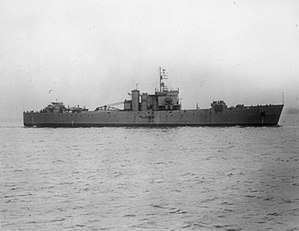HMS Bruiser (F127)
 HMS Bruiser | |
| History | |
|---|---|
| Name: | HMS Bruiser |
| Ordered: | 6 March 1941[1] |
| Builder: | Harland and Wolff |
| Launched: | 27 October 1942 |
| Commissioned: | 12 March 1943 |
| Out of service: | 1946 |
| Fate: | Scrapped Bilbao 1973 [2] |
| General characteristics | |
| Type: | Landing Ship, Tank Mark I |
| Displacement: | 3,620 |
| Speed: |
|
| Capacity: | 13 Churchill Infantry tanks, 27 vehicles, 193 men |
| Complement: | 169 |
| Service record | |
| Commanders: | Lt.Cdr. Joseph Stretch, RD, RNR, A B Lee, RNR |
| Operations: | |
HMS Bruiser, pennant number F127[1] was built as a Landing Ship, Tank (LST(1)) at Harland and Wolff. Launched in October 1942 and commissioned the following March, she saw service as part of the Allied invasion of Italy.
Design and development
HMS Bruiser was the second of the LST Mk.1 class ships which could carry 13 Churchill tanks, 27 other vehicles and 193 men. It had a high speed even when laden for the assault (about 18 knots) but did not have a shallow draught, which meant that a 140 ft (43 m) long bow ramp had to be added and this took up a lot of room inside the ship.
Bruiser had only two sister ships, as plans to build more in the United States led instead to a simpler though slower design capable of similar capacity but with a much shallower draught.
Service
Bruiser took part in the Salerno landing[3] in 1943. In 1944, she was refitted as a "Fighter Direction Ship", for use during the Normandy landings in controlling fighter aircraft by GCI. Later in 1944 she took British troops back into Athens in Greece[3]. Bruiser was sold into merchant service in 1946.
Commanding officers
| From | To | Captain |
|---|---|---|
| 16 Jan 1943 | 25 Nov 1944 | Lt.Cdr. Joseph Stretch, RD, RNR |
| 25 Nov 1944 | mid 1945 | A B Lee, RNR |
See also
- HMS Boxer
- HMS Thruster
References
- 1 2 "HMS Bruiser (F 127)".
- ↑ "HMS Bruiser". Retrieved 11 April 2018.
- 1 2 "bbc".
Publications